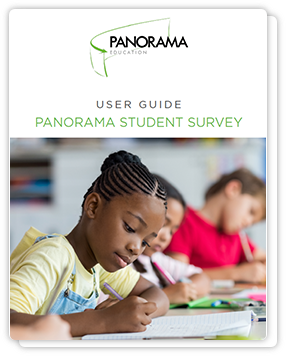Students spend more than 1,000 hours in classrooms each year, but too often their voices are left out of the conversations that shape their learning.
Educators work hard to build meaningful, engaging environments, yet many schools still face challenges in gathering authentic student input—and turning that feedback into action. The reality is that collecting student perspectives has become an essential practice for district and school leaders who want to make data-informed decisions that strengthen both instruction and school climate.
When schools listen to students, they uncover insights into what’s working, what needs improvement, and where to focus next. By weaving student voice into decision-making, leaders can identify patterns in student experiences, measure the impact of initiatives, and make changes that foster more responsive, student-centered learning environments.
Ultimately, student voice data isn’t just about hearing from students. It’s about using their perspectives to drive lasting improvements that lead to better outcomes for every learner.
What Is The Purpose of Student Feedback in Education?
The purpose of student feedback in education is to give schools a clear window into the learner’s perspective. By capturing how students experience academics, instructional methods, and the overall school environment, districts can make decisions that truly improve the educational experience.
Student feedback offers direct insight into how teaching practices and school policies shape learning in real time. When collected systematically, this data helps districts pinpoint which instructional strategies are most effective, surface early signs of attendance or behavior challenges, and measure whether initiatives are meeting student needs.
With this information, school leaders can move beyond outdated or incomplete data. Instead, they can use student voice to guide curriculum choices, adjust teaching strategies, and refine school programs where improvements will make the biggest impact. Students themselves often highlight barriers to their learning and point to the supports that help them thrive.
Perhaps most importantly, listening to student voice builds trust. When students see their input shaping real changes, they feel valued as partners in the learning process. That trust leads to stronger engagement, deeper investment, and better outcomes for every learner.
Why Student Feedback Matters
Student feedback serves many purposes across a school community. For teachers, it provides real-time insight to adjust lessons based on what students say helps them learn best. For principals, it’s a tool to shape school policies and strengthen the overall climate.
Counselors can use student voice to spot patterns—whether it’s academic challenges, attendance barriers, or well-being needs—and respond with targeted support. At the district level, leaders rely on student feedback to guide decisions about funding, resource allocation, and program planning.
When every level of the system takes student perspectives into account, schools are better equipped to create learning environments where students feel heard, supported, and set up for success.
1. Student Voice Drives School ImprovementStudents offer a perspective on learning that no observation or assessment alone can capture. Their feedback provides firsthand insights into classroom effectiveness and reveals where there may be gaps between intended outcomes and actual experiences. When students share what’s working—and where lessons miss the mark—educators gain a clearer picture of how to improve instruction.
Student input also helps schools surface barriers to engagement and academic success before they become widespread challenges. Because students experience learning every day, they often notice patterns in teaching effectiveness that may not be visible to administrators. By paying attention to these insights, schools can respond proactively, strengthen instructional practices, and create environments where every learner has the chance to succeed.
2. Benefits for Academics, Behavior, and AttendanceSchools that use student feedback see measurable improvements in academic achievement by aligning teaching methods with what students say works best. Student voice initiatives also increase engagement by showing that student opinions matter.
Collecting feedback regularly strengthens teacher-student relationships and builds ongoing dialogue about classroom experiences. When schools take a data-driven approach to climate, they can reduce behavioral issues and improve attendance.
3. Provides Unique Student Perspectives
Students notice classroom dynamics and peer interactions that adults may overlook, offering valuable insights into the social patterns that shape learning. Their feedback captures many dimensions of the school experience, including how policies make them feel valued.
Ways to Collect Student Feedback
Schools can gather student input in a variety of ways, each offering unique insights. Student feedback surveys capture broad perspectives from large groups, while interviews and focus groups provide deeper context. Quick classroom strategies—like polls, suggestion boxes, exit tickets, or reflection journals—create ongoing feedback opportunities that give educators a real-time view of student experiences.
Structured SurveysFeedback surveys allow districts to capture honest feedback at scale, giving voice to students across grade levels. With Panorama’s Student Survey, leaders can use standardized questions to compare results across classrooms, schools, and even over multiple years. This ensures the data is both reliable and actionable for decision-making.
Regular administration makes it possible to track progress and identify trends over time. Surveys are designed with grade-appropriate language so responses are meaningful from elementary through high school. Multiple-choice and rating scale items provide clear, quantifiable data, while open-ended questions uncover the nuanced feedback and specific suggestions that drive continuous improvement.
Focus Groups and InterviewsSmall group discussions uncover the stories behind survey responses, providing context that numbers alone can’t capture. Student interviews add nuance to quantitative data, while focus groups allow for real-time clarification and follow-up questions.
Structured conversations help surface concrete suggestions for improvement, and facilitated discussions create safe spaces for students—including those who may be quieter in larger settings—to share their perspectives.
Digital Feedback ToolsReal-time polling during class captures immediate student reactions to lessons and activities. Digital suggestion boxes provide a way for students to share feedback year-round, while mobile-friendly platforms make it easy for more students to participate. When feedback tools integrate with existing school technology, the process becomes simple for both students and staff, ensuring input is collected consistently and acted on quickly.
Classroom-Level CollectionExit tickets provide daily feedback on lessons and activities, giving teachers the chance to adjust instruction in real time. Reflection journals capture student experiences over time, while peer feedback helps students articulate their learning preferences.
Teacher-student conferences create personalized opportunities to share input, and weekly check-ins allow educators to monitor ongoing engagement and satisfaction. Project-based feedback adds another layer, inviting students to reflect on their growth and provide input on specific learning experiences.
Turning Data into Action
Student feedback only creates value when it leads to visible improvements. Data analysis must translate into concrete changes in classrooms and schools. When feedback is collected but not acted on, students lose trust in the process—and participation drops in future surveys.
Action PlanningData-driven goal setting helps schools focus improvement efforts on the areas of greatest need. Involving stakeholders builds buy-in, while clear timelines create accountability for implementation.
Aligning resources with identified priorities ensures funding supports the work that matters most. Success metrics define how progress will be measured, communication plans keep everyone informed, and pilot programs allow districts to test changes before scaling them more broadly.
Instructional ImprovementsCurriculum adjustments help address learning gaps that students identify, while changes to teaching methods respond to their learning preferences. Feedback on assessments can guide shifts in evaluation practices, and student input on instructional quality can inform professional development where teachers need the most support.
Climate and Culture ChangesPolicy revisions can address student concerns about the school environment, from discipline practices to scheduling. New programs or activities can be introduced in response to student suggestions, while communication improvements ensure students stay informed about decisions that impact them. Relationship-building initiatives further strengthen connections between students and staff, creating a more supportive and responsive school community.
Monitoring ProgressFollow-up surveys help measure whether changes truly address student concerns. Regular check-ins with student representatives keep student voice present in decision-making, while data tracking documents progress over time. When initial actions don’t produce the desired outcomes, clear adjustment protocols ensure schools can refine their approach and stay responsive to student needs.
How Panorama Surveys and Engagement Improve Student Feedback
Education leaders know student perspectives are essential, yet many schools struggle to collect feedback that leads to real change. Panorama Surveys and Engagement provides research-backed surveys on teaching, climate, safety, relationships, and belonging—tailored by grade level to ensure every student’s voice is heard.
With automated analysis and clear dashboards, leaders can identify trends, track progress, and connect student voice to academic and behavioral outcomes.
Download Panorama’s Student Survey today and start turning student feedback into meaningful school improvement.





.jpg)

.webp?width=478&height=557&name=panorama_student_survey-1%20(1).webp)